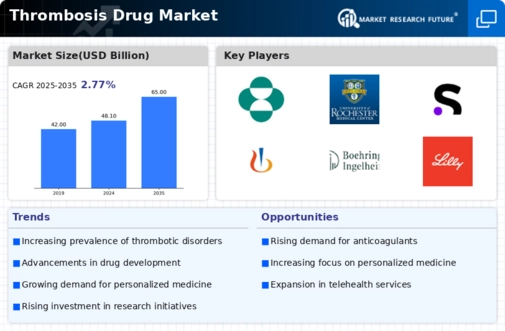Rising Incidence of Thrombosis
The increasing prevalence of thrombosis-related conditions, such as deep vein thrombosis and pulmonary embolism, is a primary driver of the Thrombosis Drug Market. According to recent estimates, the incidence of venous thromboembolism is approximately 1 in 1,000 individuals annually, with higher rates observed in specific populations, such as the elderly and those with comorbidities. This growing patient population necessitates the development and availability of effective thrombosis drugs, thereby propelling market growth. Furthermore, the aging demographic is likely to contribute to a sustained rise in thrombosis cases, which in turn may lead to increased demand for innovative treatment options within the Thrombosis Drug Market. As healthcare systems adapt to these trends, the focus on preventive measures and early intervention strategies is expected to further stimulate market expansion.
Advancements in Drug Development
Innovations in drug development are significantly influencing the Thrombosis Drug Market. The introduction of novel anticoagulants, which offer improved safety profiles and efficacy compared to traditional therapies, is reshaping treatment paradigms. For instance, direct oral anticoagulants (DOACs) have gained traction due to their ease of use and predictable pharmacokinetics. Market data indicates that the DOAC segment is projected to witness substantial growth, potentially reaching a valuation of several billion dollars in the coming years. Additionally, ongoing research into personalized medicine and targeted therapies may lead to the emergence of tailored treatment options for thrombosis patients, further enhancing the therapeutic landscape. These advancements not only improve patient outcomes but also drive competition among pharmaceutical companies, thereby fostering innovation within the Thrombosis Drug Market.
Increased Awareness and Screening
Heightened awareness regarding thrombosis and its associated risks is contributing to the growth of the Thrombosis Drug Market. Public health campaigns and educational initiatives have led to improved recognition of symptoms and risk factors, prompting individuals to seek medical attention sooner. This proactive approach is likely to result in earlier diagnosis and treatment, thereby increasing the demand for thrombosis medications. Furthermore, the implementation of routine screening protocols in high-risk populations, such as those undergoing surgery or with a history of cardiovascular disease, is expected to enhance detection rates. As awareness continues to rise, healthcare providers may prioritize thrombosis management, leading to a more robust market for thrombosis drugs. The interplay between education and clinical practice is thus pivotal in shaping the future landscape of the Thrombosis Drug Market.
Regulatory Support for New Therapies
Regulatory bodies play a crucial role in shaping the Thrombosis Drug Market by facilitating the approval of new therapies. Recent trends indicate a more streamlined regulatory process for novel anticoagulants and other thrombosis treatments, which may expedite their entry into the market. For instance, the adoption of accelerated approval pathways allows for quicker access to innovative therapies that demonstrate promising results in clinical trials. This regulatory support not only encourages pharmaceutical companies to invest in research and development but also enhances patient access to cutting-edge treatments. As regulatory frameworks evolve to accommodate advancements in medical science, the Thrombosis Drug Market is likely to experience accelerated growth, driven by the introduction of new and effective therapeutic options.
Growing Investment in Healthcare Infrastructure
The expansion of healthcare infrastructure is a significant driver of the Thrombosis Drug Market. Increased investment in hospitals, clinics, and outpatient facilities enhances the capacity to diagnose and treat thrombosis-related conditions effectively. As healthcare systems evolve, there is a growing emphasis on integrating advanced diagnostic tools and treatment modalities, which may lead to improved patient outcomes. Market data suggests that regions with robust healthcare infrastructure are witnessing a surge in thrombosis drug utilization, as healthcare providers are better equipped to manage complex cases. Additionally, the rise of telemedicine and digital health solutions is likely to facilitate access to thrombosis care, particularly in underserved areas. This investment in healthcare infrastructure not only supports the delivery of thrombosis treatments but also fosters a more comprehensive approach to patient management within the Thrombosis Drug Market.


















Leave a Comment